30: Breaking News - A Star is Born!
( \newcommand{\kernel}{\mathrm{null}\,}\)
Search for the latest papers -- constantly updated:
Latest update: March 24, 2005
Much has happened since the last update. A brief summary of some of the news follows.
- Grosso et al. (to appear in A&A sometime soon) describe X-ray spectra of V1647 Ori taken on 2004 April 4. They find variations in both the brightness and hardness of the source over the 38,000 second exposure. There is a very exciting hint of periodicity in the X-ray brightness, which might provide information on the physical nature of the X-ray luminosity. The XMM telescope is scheduled to observe V1647 Ori again very soon, for about 130,000 seconds starting 2005 Mar 24. The Chandra X-ray telescope is scheduled to observe the source for 20,000 seconds soon thereafter, around 2005 Apr 11.
- Muzerolle et al. (ApJ 620, 107, 2005) report on Spitzer near-IR photometry of V1647 Ori in its early post-outburst phase (March 2004). They find that the brightness of the star increased by roughly the same factor of 15-20 across the optical and near-IR, as their Figure 2 below shows (pre-outburst are plus signs, post-outburst are open and blue diamonds). Their vote on the FUor vs. EXor question is "some of each."
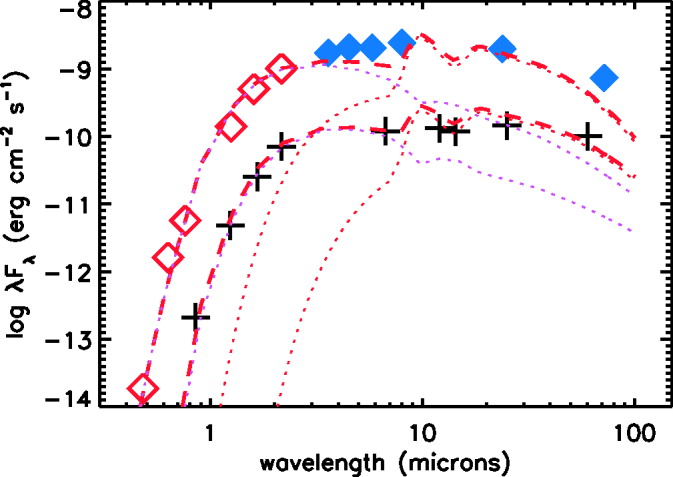
- Kun et al. (astro-ph 0408342) use optical and near-IR data from 2004 Feb - 2004 Apr to infer several properties of the system. Their Figure 7 shows their model for the geometry of the system. They conclude that the outburst was not due to a clearing of dust from our line of sight, but rather due to an increase in the luminosity and temperature of the source. Based on their optical and near-IR data, they find no evidence for magnetic accretion, and so vote for FUor over EXor.
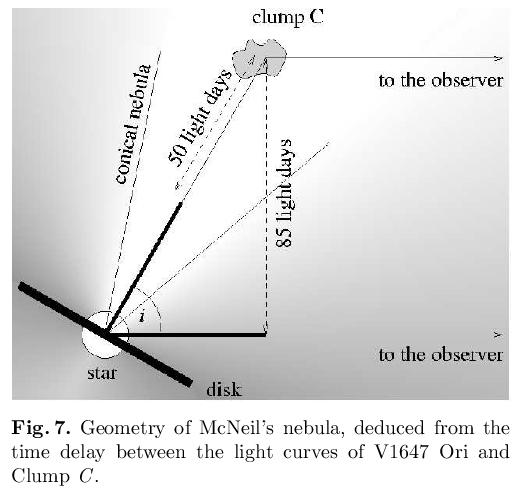
- The star has faded slightly in the optical and near-IR.
- Semkov (IBVS 5578) provides VRI photometry from 2004 Aug 18 to 2004 Oct 03. There is a gentle rise in all passbands to a peak around 2004 Sep, with perhaps a slightly sharper decline afterwards.
- Gianluca Masi, R. Wilcox and F. Mallia report measurements of V1647 Ori in unfiltered images taken with the 0.36 SoTIE reflector in Chile. They find
Date JD unfiltered mag 18 Mar 2004 2,453,083 16.15 14 Sep 2004 2,453,263 15.9 16 Mar 2005 2,453,446 16.6 Gianluca provides the following images showing the evolution of the star over this time. The images run from left (18 Mar 2004) to right (16 Mar 2005). V1647 Ori lies at the apex of the fan-shaped nebulosity at the top-center of the frame. The white bars indicate two different long-term variables which Gianluca is studying. Gianluca adds:
... we report also an evident fading of the nebula too, which follows - of course - the brightness evolution of the star.
You can also look at an animated GIF Gianluca made, showing these three images in a little movie.
- Ted Simon notes that preliminary reductions of near-IR spectra taken with the IRTF indicates that the overall brightness of V1647 Ori around 1-2 microns has decreased by roughly a factor of 2 over the past year. This is similar to the drop in the optical shown in the image above...
Older update: September 1, 2004
In IAUC 8396, Aspin and Reipurth report that an image taken with the Gemini guide camera on Aug 29 shows McNeil's Nebula and its central star to be "in its elevated state." I interpret this to mean "still roughly as bright as it was when it went behind the Sun," consistent with my result from Aug 22.
Older update: August 27, 2004
For your viewing pleasure, a graph showing the evolution of McNeil's Nebula in the infrared, visible, and X-ray. This is a slightly updated version of one of the figures from Kastner et al. in Nature (July 22, 2004) . You can find links to local copies of that paper below, in the July 23, 2004, entry.
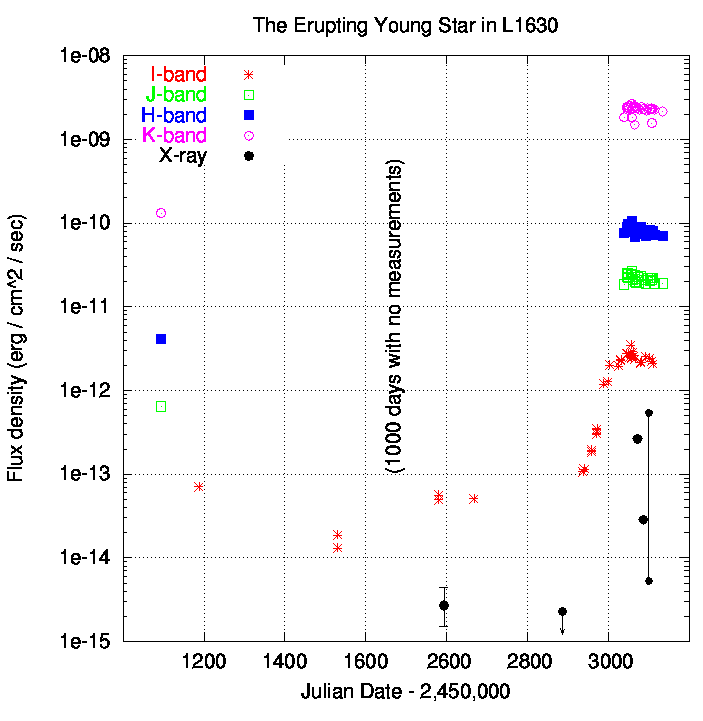
Older update: August 25, 2004
Two items today: a new paper, and a lousy (first?) attempt to measure the optical brightness of the central star as it returns to the nighttime sky.
- Kun et al., in astro-ph 0408432, analyze optical and near-IR measurements of V1647 Orionis from the winter and spring of 2003-2004. They attempt to make a physical model of the circumstellar matter in the neighborhood of the star. They also suggest that the outburst was due to an intrinsic increase in the luminosity of the central object (rather than a decrease in extinction), and identify the object as an FUOr, rather than an EXor. That means that it ought to stay bright for years ...
- ... which leads into the second item. I noticed that Orion is starting to appear again in the eastern sky at sunrise, which means that we should soon be able to observe V1647 again. Will it be fainter than it was in May (as one would expect for an EXor), or the same brightness (as one might expect for a FUOr)? I used the RIT Observatory's 12-inch telescope to take images at a frighteningly large airmass on the morning of Aug 22, 2004, hoping to find out. But it wasn't really successful ....
Older update: August 18, 2004
Peregrine McGehee and coauthors describe the change in optical and near-IR colors of V1647 Orionis from its "quiescent" state to its outburst.
- The V1647 Ori (IRAS 05436-0007) Protostar and its Environment From their abstract:
.... the color changes associated with brightening suggest an EXor outburst rather than a simple dust clearing event.
Vacca, Cushing and Simon present near-IR spectroscopy of the object taken on March 9, 2004, with the SpeX instrument:
- Near-Infrared Spectroscopy of MCNeil's Nebula Object From their abstract:
.... all evidence suggests that McNeil's Nebula Object is a heavily embedded low-mass Class I protostar, surrounded by a disk, whose brightening is due to a recent accretion event.
Older update: July 23, 2004
Lots of new stuff in the past month.
- As mentioned in earlier notes, the Chandra X-ray Observatory pointed to the new object several times during Spring 2004; the X-ray flux increased by roughly a factor of 50 above its pre-outburst value, which approximately matches the increase in the near-IR flux.
- "An X-ray Outburst from the Rapidly Accreting Young Star That Illuminates McNeil's Nebula" by Kastner et al. describes these X-ray measurements and provides a few comments on their implications. This paper was published in the July 22, 2004 issue of the journal Nature . The reference is Nature vol. 430, p. 429 (2004). You can also find a copy on the astro-ph archive as astro-ph/0408332
- Joel Kastner's presentation summarizes what we knew as of June, 2004, and looks forward to additional observations (which Joel won for the second half of 2004!).
- The Chandra X-ray Observatory's press release from July 22, 2004
- Space.com's version of the story
- Universe Today's article
- V1647 Ori (IRAS 05436-0007) in Outburst: the First Three Months a paper by Walter, Stringfellow, Sherry, and Pollatou, provides a good deal of optical and near-IR photometry, plus some spectroscopy.
- National Public Radio's "Science Friday" talk show included a segment on McNeil's Nebula on Friday, July 23, 2004.
Older update: June 15, 2004
The star finally has an official name! IAUC 8354 announces that the object is now called V1647 Orionis.
Older update: June 12, 2004
Measurements of the new object in the mid-IR (low-res spectra between 7.5 and 12.5 microns) and sub-mm (450 and 850 microns) are reported in astro-ph 0406089 , by Andrews, Rothberg and Simon. A portion of their Abstract:
The 12 micron flux of this source has increased by a factor of 25 after the outburst, whereas the submillimeter continuum remains at its pre-outburst level. The bolometric luminosity has increased by at least an order of magnitude, to ~34 L_sun, and is likely less than 90 L_sun. The mid-infrared spectrum exhibits a strong and red continuum with no emission or absorption features. The infrared slope of the spectral energy distribution characterizes the illuminating source as a flat-spectrum protostar, in both its active and quiescent states.
Peregrine McGehee presented a poster paper on optical and near-IR photometry of the environment of the new object, both before and during outburst. A longer paper based on the data is being prepared for publication in ApJ.
Peregrine also points out that a paper discussing FU Ori outbursts in a theoretical context, astro-ph 0406264 by Lodato and Clarke, may be of interest.
Older update: May 13, 2004.
Doug Finkbeiner has created new color mosaics of the field around McNeil's object, based on scans from the Sloan Digital Sky Survey . See them down below . Doug provides a warning:
Note that an asinh stretch is used ... and that the colors saturate to the correct RGB color ratio instead of to white.
Older update: Apr 16, 2004.
Bruce Gary's recent I-band photometry suggests that the brightness of the object may have reached a first peak, faded just a bit, then increased slightly before starting to fade again. Could this very small secondary peak be due to light echoes, rather than an intrinsic increase in the light from the central source? Bruce has some evidence that it very well may be due to a light echo; see Bruce's speculations on a light echo, which are based on a careful analysis of the appearance of the source's Point-Spread-Function (PSF).
Older update: Apr 14, 2004.
A paper by Abraham et al. has appeared on astro-ph, describing the infrared and sub-mm properties of the object:
They conclude that the object has a disk of about 0.5 solar masses, a pre-outburst bolometric luminosity of 5.6 solar, and is probably a class II protostar of age about 400,000 years.
Older update: Apr 2, 2004.
The technical papers are starting to appear:
- IRAS 05436-0007 and the Emergence of McNeil's Nebula by Reipurth and Aspin provides an early optical and early near-IR spectrum.
- Mc Neil's Nebula in Orion: The Outburst History , by Briceno et al., presents the optical history seen in the CIDA movie
Older update: Mar 30, 2004.
You can hear Jay McNeil talk about his discovery on an audio clip from NPR's "Weekend Edition". In other news, we have learned that the Spitzer Space Infrared Telescope not only took images of the field on March 15 with the (mid-IR) MIPS instrument (we knew that already), but also took images with its (near-IR) IRAC instrument a week earlier, March 7. Unfortunately, we haven't been able to look at this data yet ...
Older update: Mar 23, 2004.
Several items today: Joel Kastner tells me that Chandra has successfully observed the object for a second time since outburst, about 15 days after the first X-ray measurement. I've predicted that the source will be more than twice as faint as it was at the earlier epoch; Joel tells me he'll be able to make a good measurement sometime within the next week or so.
I've also come across a nice, big, false-color mosaic of the M78 region which includes the new object. Go to the 2MASS Atlas Image Gallery of HII regions, star formation regions, and reflection nebulae and scroll down about halfway through the page. It was hard for me to see on the little thumbnail, but the full-size version shows the object very clearly. Note that this is based on images taken several years ago, so it's a "pre-outburst" IR image.
Old update: Mar 22, 2004.
The Gemini Observatory has put out a press release which includes some nice pictures of the star, some astronomers (including Jay McNeil), and an artist's rendition of what may be happening.
Old update: Mar 16, 2004.
Bruce Gary, of Hereford, Arizona, has been following the optical evolution of the new star since mid-February. He finds that in the R and I bands, the star has reached its peak brightness and is now starting to fade. For all the details, look at Bruce Gary's measurements of the new star.
Old update: Mar 15, 2004.
César Briceño has made a movie showing the evolution of the new star and its nebulosity in the visible part of the spectrum, based on images taken with the 1m Schmidt telescope of Llano del Hato National Astronomical Observatory in Venezuela. Go to Cesar's movie page to see the animation. Also, the Spitzer satellite acquired infrared images of the star last night.
Old update: Mar 8, 2004.
Joel Kastner reports that a Chandra X-ray image shows the new star to be much brighter than it was in the pre-outburst X-ray image. Rah! More analysis soon from Joel ....
Old update: Mar 1, 2004.
Arne Henden provides a color composite in BVI of the new object, taken Feb 22, 2004.
Old update: Feb 28, 2004.
See some color pictures of the field from 199 and 2002.
Old update: Feb 21, 2004.
Peregrine McGehee reports that the literature contains several images of the field taken in years past. You can see some scanned versions of these images and speculation on what they mean in the Feb 21 section of this page, below. There's also a very pretty color picture of the area made by David Schlegel from SDSS scans of the area.
Old update: Feb 20, 2004.
Joel Kastner describes X-ray emission from the new object in a Chandra image taken in 2002. It appears that Chandra will be looking at the new star as a Target Of Opportunity in early March!
A new star appears in early 2004
The position of the new star, based on 2MASS K-band image from 1999, is
RA = 05:46:13.1 Dec = -00:06:05 (J2000)
In the past few weeks, a new star has appeared to our visible instruments in the Milky Way Galaxy. It's not a "nova" or "supernova" -- the result of a gigantic explosion near the end of a star's life -- but a stellar birth!
In one particular region of the Milky Way lies a giant cloud of gas and dust, which astronomers call M78.
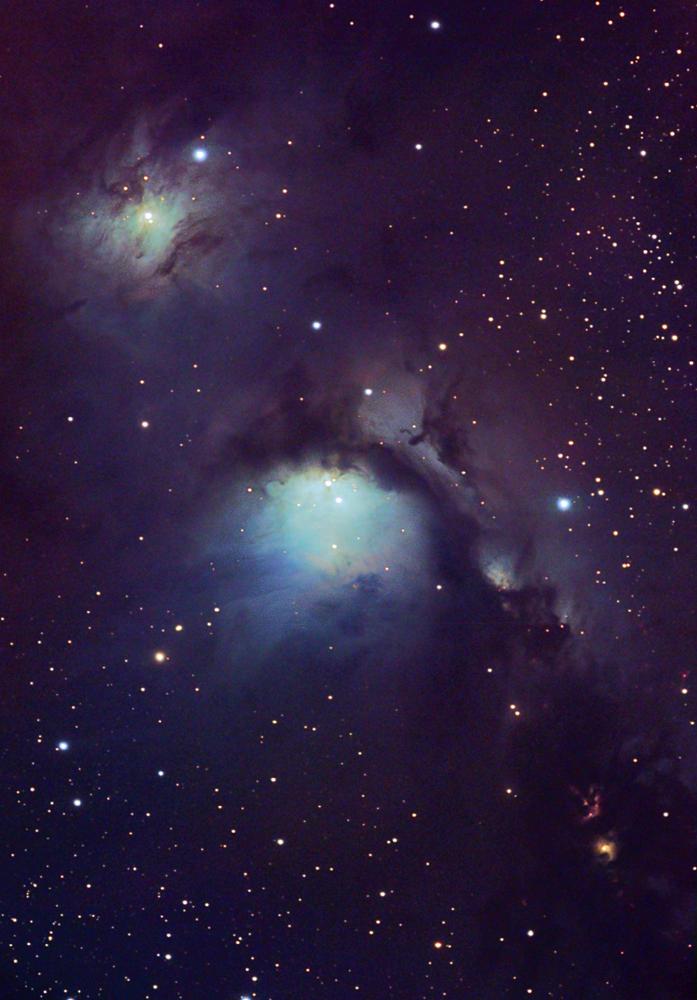
Image courtesy of Daniel Verschatse (Antilhue Obs.)
Young stars are forming out of this cloud, and their light excites the remaining gas, causing it to glow. We call the beautiful glowing cloud a nebula.
Note that the region to the lower-right of M78 is rather dark:
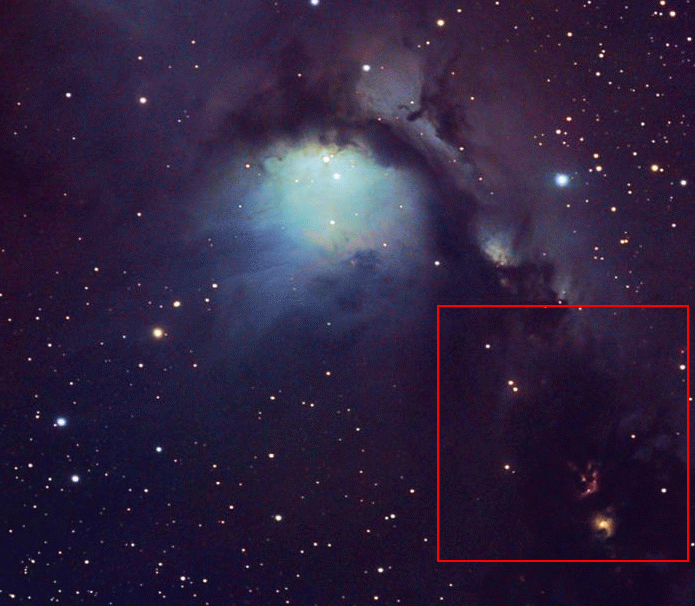
In this region, the thick dusty clouds block light from stars hidden behind them. Only a few stars manage to penetrate the gloom. Because blue light is scattered and absorbed more easily than red light, these stars appear redder than they truly are.
Let's concentrate on a small region near the center of the box. Way back in 1951, astronomers photographed this region in red light as part of the Palomar Observatory Sky Survey (POSS). The image shows a few stars, with a nice pair near the center.
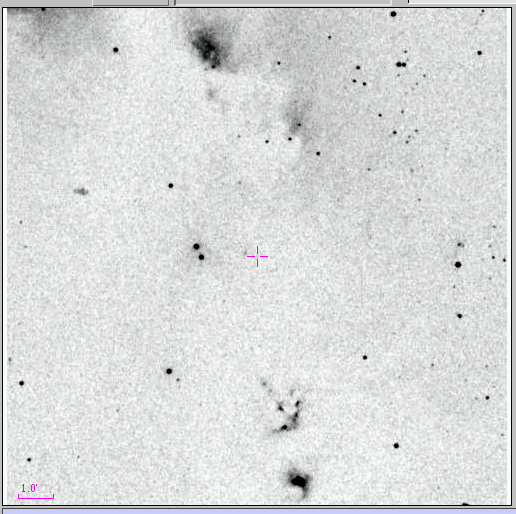
In 1990, a second photographic survey (POSS II) again photographed the region in red light, and found, well, pretty much the same picture. The pair of stars near the center is again the most prominent feature.
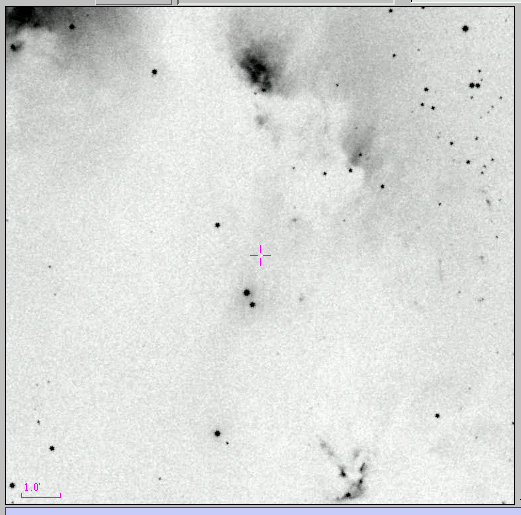
In 1998, the 2MASS project surveyed the area, this time at infrared wavelengths. Because infrared light has a longer wavelength than visible light, it ought to penetrate the dusty clouds more deeply and show us any objects hidden within. You can see several new stars, to the lower right of the bright pair, which aren't apparent in the visible-light images.
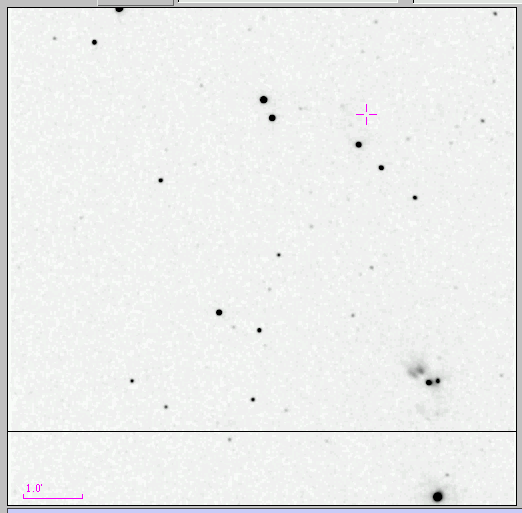
Hmmmm.... These stars must be hidden within cocoons of dust and gas.
In January, 2004, however, ordinary visible-light photographs of the region suddenly revealed a new object. The first report came from J. W. McNeil, of Paducah, Kentucky, who noticed the new object on Jan 23, 2004. Compare these two pictures taken by Japanese astronomer Yasuo Sano: in 2001, on the left, and in 2004, on the right:
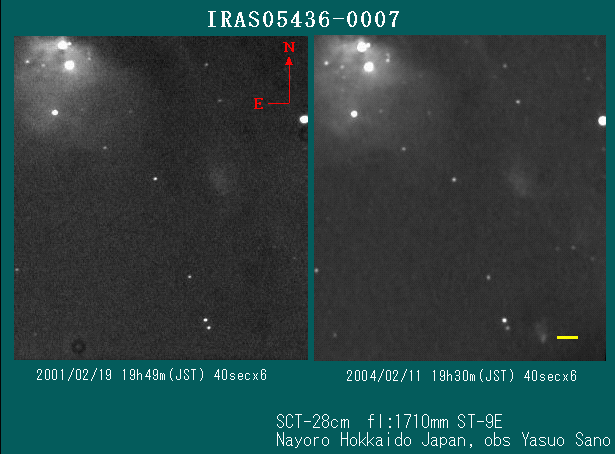
The right-hand picture above was taken on February 11, 2004. The picture below, also from Sano-san, was taken one night later.
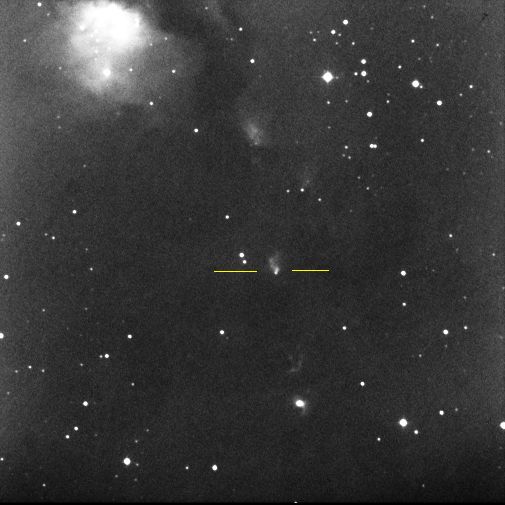
Sano-san's pictures indicate that the star is growing brighter quickly, within the span of a single day. His measurements:
| object | YYYYMMDD(UT) | mag | code |
|---|---|---|---|
| IRAS05436-0007 | 20040211.455 | 14.46CR | San.VSOLJ |
| IRAS05436-0007 | 20040212.421 | 14.07CR | San.VSOLJ |
Yasuo Sano (Nayoro, Hokkaido,Japan)
Instruments: 28cm-SCT + ST-9E exp 30sec(2004/02/11). 25cm-NT + ST-9E exp 30sec(2004/02/12)
Comparison stars: Henden 3 star R mag
Kamil Hornoch also finds that the object becomes brighter:
Date: Fri, 13 Feb 2004 11:29:47 +0100
From: Kamil Hornoch
Subject: New nebula near M78: additional photometry
...
Most southern star (and brightest star included in a new nebula)
increased its brightness of about 0.20 mag between Feb. 11.913 UT
and 12.908 UT.
Let's compare the location of this new object in the visible to the infrared picture taken several years ago. Here's a zoomed-in view of the optical picture -- click here to reach a "blinking" page, where you can switch back and forth between visible and IR.
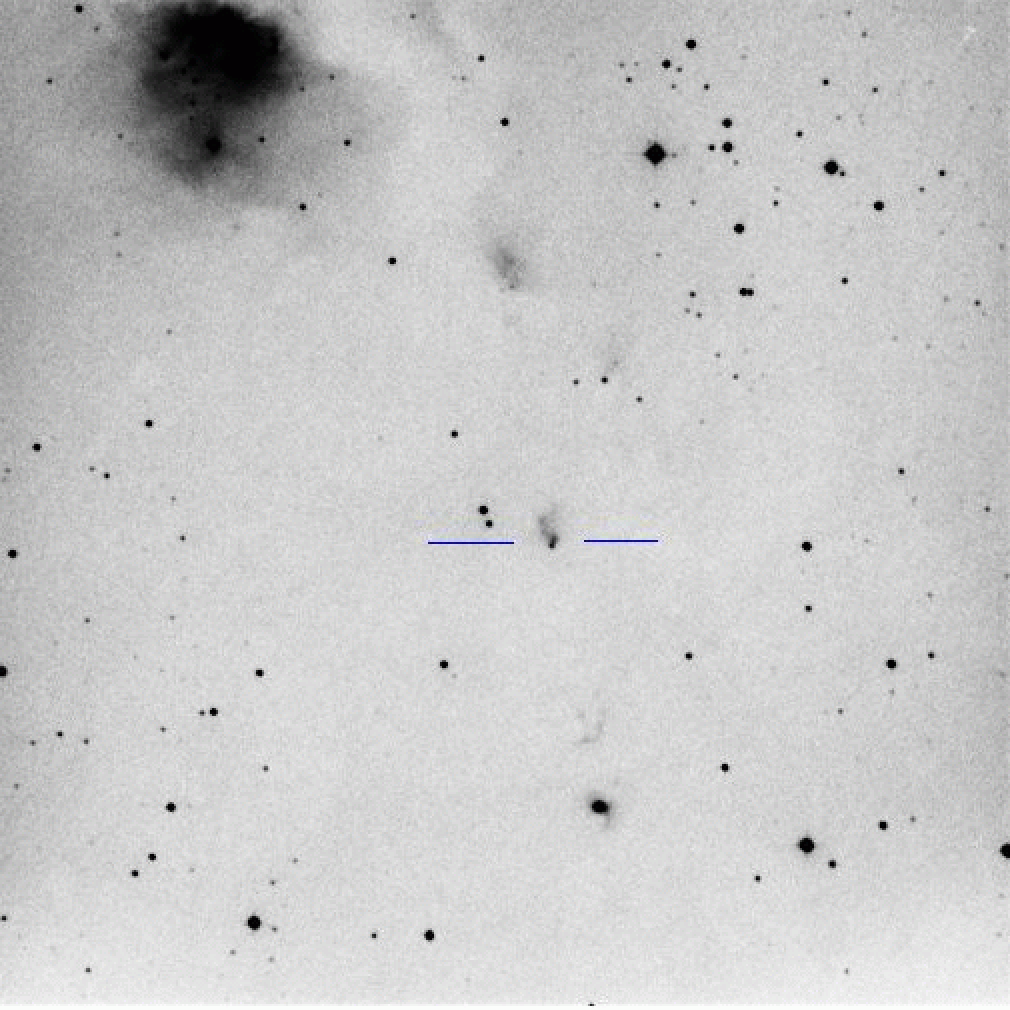
Yes! The star really was there back in 1999 (and probably for thousands of years earlier), but it has just now become visible in the optical. Why? It must be blowing away the cocoon of dust and gas which surrounds it -- we think all young stars have strong winds of this kind. Over the past few years, the wind has managed to clear enough dust that the visible light emitted by this young star can finally make it all the way to Earth.
The position of the new star, based on 2MASS K-band image from 1999, is
RA = 05:46:13.1 Dec = -00:06:05 (J2000)
Arne Henden provides a nice R-band image of the new star taken with the 1.0-m telescope at US Naval Observatory in Flagstaff, Arizona. He also provides photometric calibration for some of the nearby stars -- see the table below.
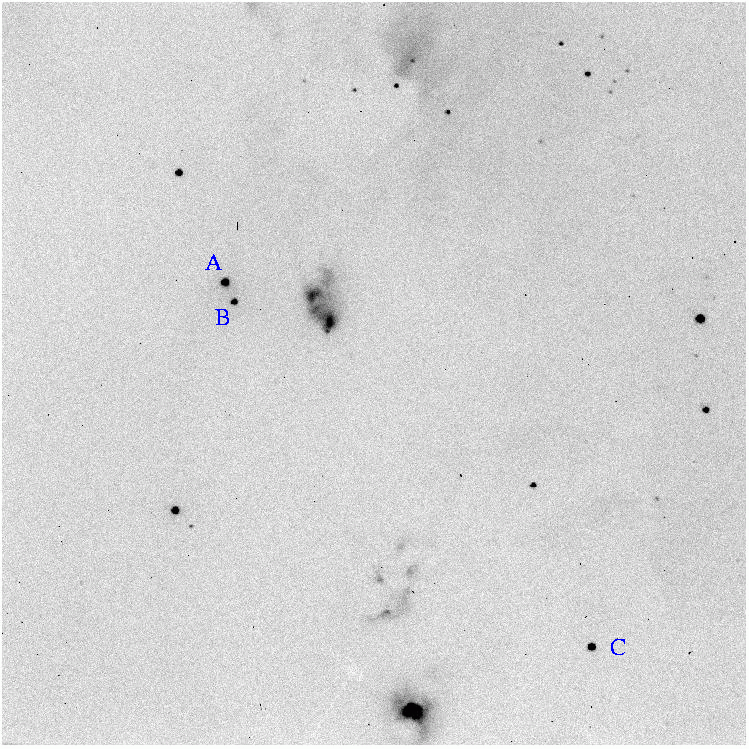
This is just a small sample of Arne's measurements for a subset of stars marked in the chart. See the full table with all the data below.
| ID | RA | Dec | V | B-V | U-B | V-R | R-I |
|---|---|---|---|---|---|---|---|
| A | 86.581120 | -0.088877 | 14.853 | 1.577 | 99.999 | 1.081 | 1.081 |
| B | 86.578727 | -0.093920 | 16.290 | 1.847 | 99.999 | 1.279 | 1.345 |
| C | 86.485580 | -0.182250 | 14.971 | 1.137 | 99.999 | 0.713 | 0.609 |
Gianluca Masi points out that star "B" is apparently variable in brightness. Taichi Kato and Brian Skiff mention that this star exhibits emission lines, and may very well be a T Tauri variable. The companion, star "A", also known as LkHA 301, is a known T Tauri star, and a variable. It is not surprising to find very young (and variable) stars in this star-forming region.
Added Feb 13, 2004, EST.
Gianluca Masi notes that this object was apparent in the optical several decades ago. He writes:
the object was observed two days ago by me and Franco Mallia, using the Tenagra II telescope. The star was really evident (the images were grabbed around 11.2 feb UT) and its astrometry reported to CBAT. Here is the image: www.campocatinobservatory.org/IRAS_05436_0007.jpg
I have also found an image of 1960s where the same feature is visible. This seems to suggest a repeated outburst of the source.
I've sent a report to CBAT. I saw evidence of the "nebula" starting on Nov 2003, since then showing an incresing brightness.
I suggest to closely monitor the object for the remaining season.
Gianluca points to this image of M78 (left below), part of the SEDS Messier gallery, available at www.seds.org/messier/large/m78.gif The photograph is part of the book The Messier Album, by John H. Mallas and Evered Kreimer, published in 1978 by Cambridge University Press. The image was taken by Kreimer from his home in Prescott, AZ, (alt 5400 feet), on Oct 22, 1966 with a 12.5-inch f/7 Cave reflector, a 15-minute exposure only Tri-X cooled to -109 F in a dry-ice camera. The film was processed in D-19 for 4 minutes, and (alas) a dodging mask was used in making the print. Tri-X peaks in the blue part of the spectrum.
The image on the left is the "old" one, from 1966; the image on the right is a half-size version of Sano-san's picture of Feb 12, 2004. Note that the nebulosity in 1966 is brightest at the top (north) end, whereas the 2004 event is brightest at the bottom.
Added Feb 15, 2004
Brian Skiff warns that it won't be easy to make accurate meassurements of the new star's brightness:
Because of the very strong reddening of this star, it will almost certainly be necessary for folks to use standard photometric filters, since color terms among various chips and varying temperatures etc on the same chip will be impossible to compensate for.
In addition, without the additional information of the the photometric aperture used, as well as details on how the strong and strongly-varying background has been dealt with, comparisons among different observers will be unworkable.
Large image scales (long focal-length and small pixels) will be required to deal with this star. The gradient of the nebula near the star might be modelled by a tilted plane (or quadratic) to determine the sky level at the star itself. Annular 'sky' zones probably won't work. The 'star' apertures will have to be very small (few arcsec only).
Added Feb 17, 2004
At last the big guys have become involved. Aspin and Reipurth report that near-IR images taken with the Gemini 8-m telescope show that the object has brightened by about 3 magnitudes in JHK, relative to the 1998 2MASS measurements. Gemini spectra reveal strong features of CO and hydrogen Brackett-gamma in emission in the IR; in the optical, H-alpha shows emission with a P Cygni profile.
Suggested readings for reports of similar events:
- Eruptive phenomena in early stellar evolution , Herbig, ApJ 217, 693 (1977)
- The 1993-1994 Activity of EX Lupi , Herbig, PASP 113, 1547 (2001). The abstract to this paper reads:
EX Lupi is a classical T Tauri star (and the EXor prototype) subject to sporadic outbursts. The historic record shows that it remains at about V=13.2 (or mpg=14.7:) for extended periods, from which it has been observed to brighten to as much as V=8.4 (on one occasion in 1955-1956). During 1993-1994 the star remained slightly above normal minimum, at about V=12.8, and from that level rose to three maxima at V=11.4 and on other occasions to about V=12.0. At minimum light an M0 V absorption spectrum is present. At outburst this spectrum is veiled by a hot continuum (well shown by an IUE exposure), the equivalent widths of the optical-region emission lines decrease, and reverse P Cygni absorption components appear at the higher Balmer lines. The outbursts are believed to be due to episodic infall onto the M0 star.
Added Feb 19, 2004
The Sloan Digital Sky Survey detected a very faint source at the position of the new star several times in the past few years. Here's an image taken in early February, 2002, in the z-band; (the SDSS z-band has an effective wavelength of about 8950 Angstroms and a width of about 1140 Angstroms).
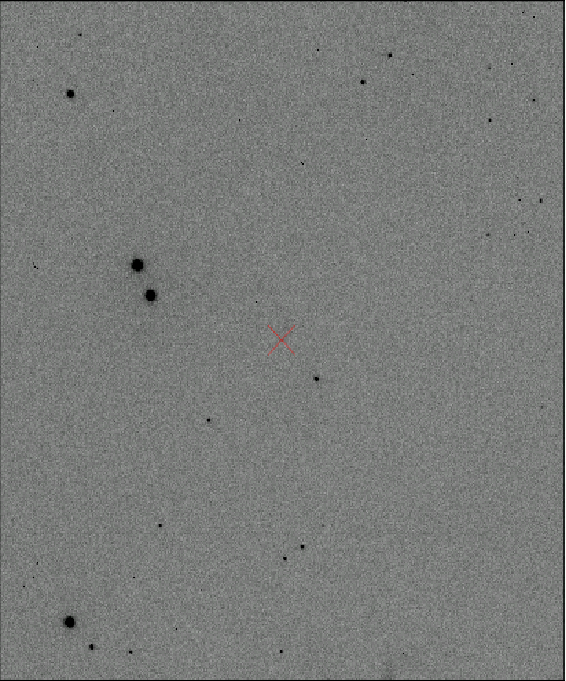
A closeup shows the object clearly, plus some very faint emission from nebulosity to its north.
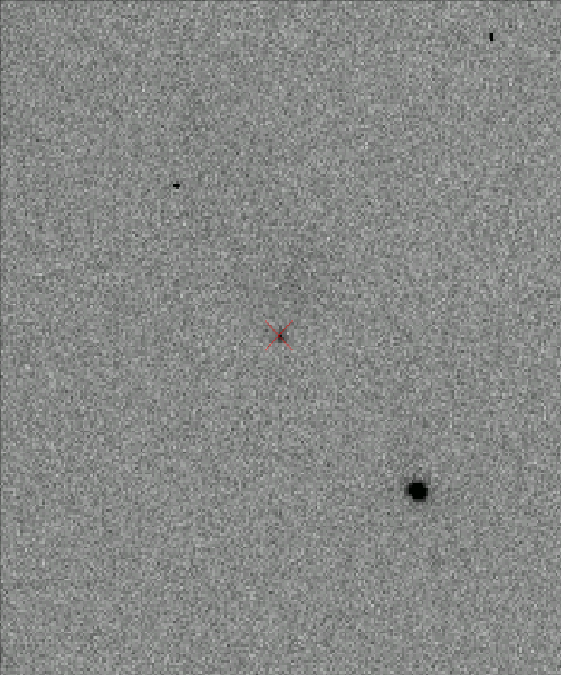
Added Feb 20, 2004
Selected tidbits from IAU Circular 8290:
- M. Halderman did _not_ detect the star and or nebulosity on Feb 6, 2003
- M. Halderman _did_ detect the star and very faint nebulosity on Nov 26, 2003
- R. Croman detected the star and nebulosity on Dec 30, 2003
Which brings us chronologically to the first person who apparently noticed something out of the ordinary: amateur astronomer Jay McNeil, who first noticed the recent outburst in an image taken on January 23, 2004. You can read Jay McNeil's own account of the events (and my local copy ). in the February, 2004, issue of the Houston Astronomical Society's newsletter. Astronomy Picture of the Day has chosen this new object as its topic for their entry for Feb 19, 2004. APOD also provides a nice color picture taken by Adam Block as part of the Kitt Peak National Observatory Visitor Program. A larger version can be found in the APOD entry for Feb 19, 2004.
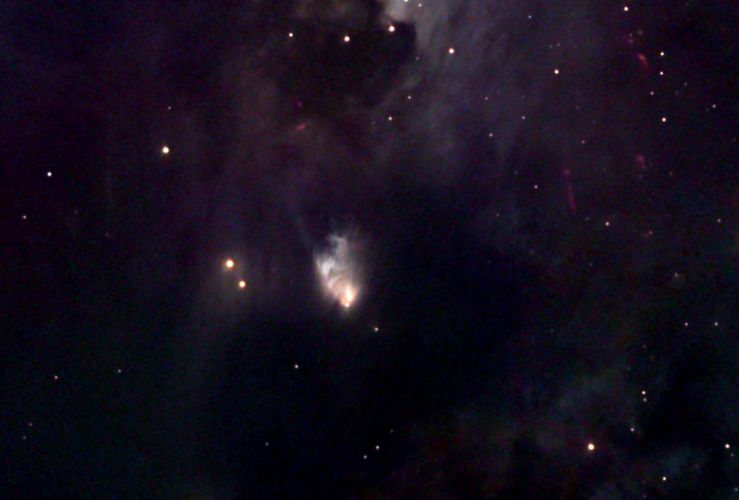
Here's a closeup of an X-ray image near the new star, courtesy of Joel Kastner and the Chandra data archive. The field is about 4x4 arcminutes, with North up and East to the left. The new object is the very weak source at center; stars A and B are the bright pair to its north-east, as in optical and IR images.
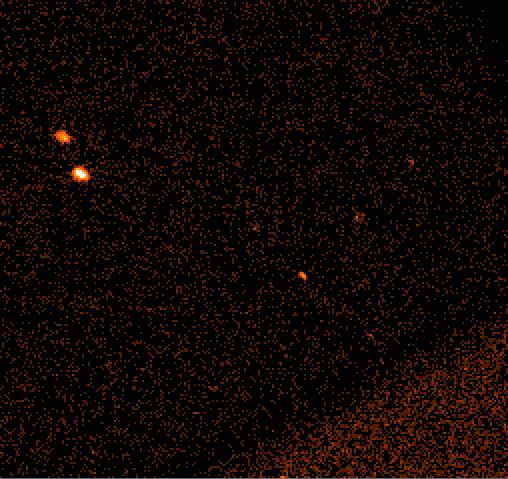
Added Feb 21, 2004
Peregrine McGehee points out a couple of existing papers which discuss the new object and its neighbors:
- Parsec-Scale Jets From Young Stars by Eisloffel and Mundt, Astronomical Journal v.114, p. 280-287 (1997). It contains images in [SII] which show nebulosity to the north of the new object.
- Dust Continuum Imaging of the HH 24 Region in L1630 by Lis, Menten and Zylka, The Astrophysical Journal, Volume 527, Issue 2, pp. 856-865 (1999). The authors mapped the region in the continuum at 350 and 1350 microns. They discuss the case of a source coincident with the new star (which they call LMZ 12) in some detail.
A color picture from the SDSS appears at the end of today's section.
Here's a chart from the paper by Eisloffel and Mundt showing [SII] emission from the area. North is up, East to the left. The two stars just to the left of the label "HH22" are the ones I've called "A" and "B" in charts above. Watch out for some image distortion on the left -- I couldn't get the page to sit flat on the scanner's platen :-(
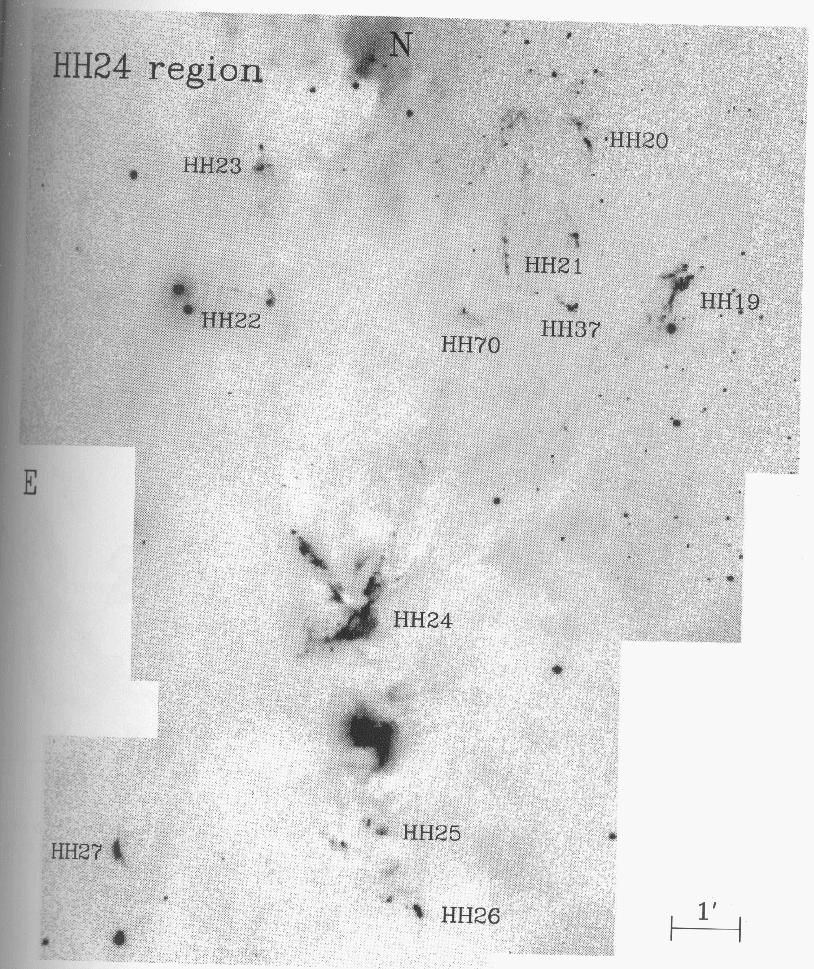
A closeup around the new object's area: [SII] on the left, from October, 1995, and R-band on the right, from mid-Feb, 2004:
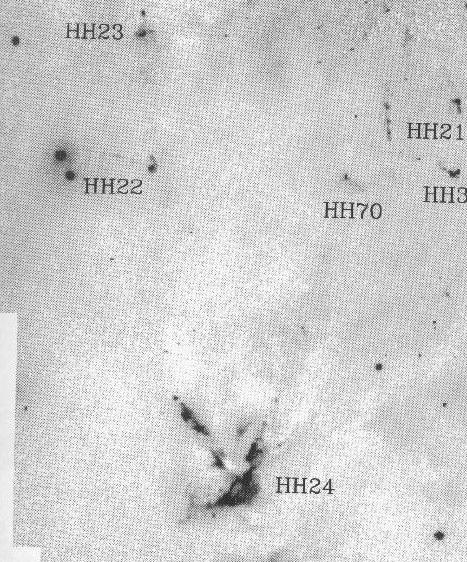
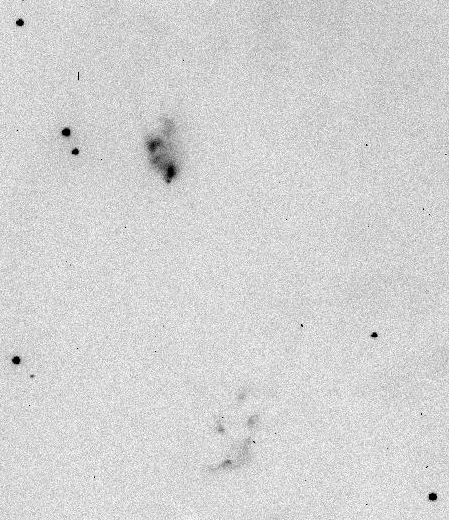
Zoom in even closer: again, [SII] from 1995 on the left, R-band from Feb 2004 on the right:
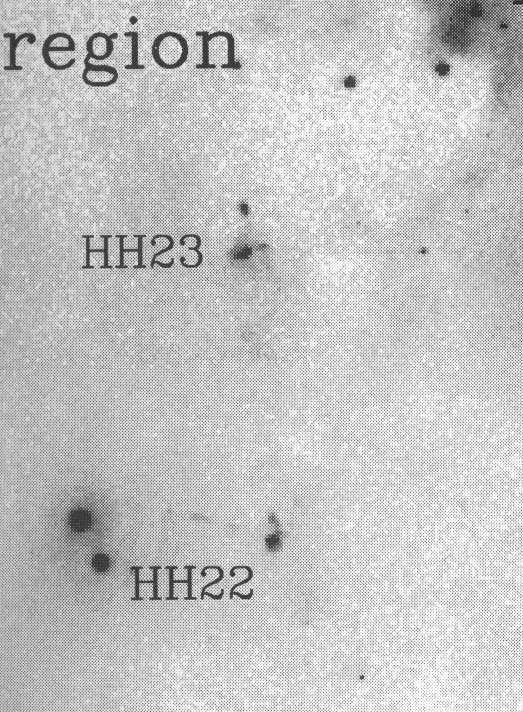
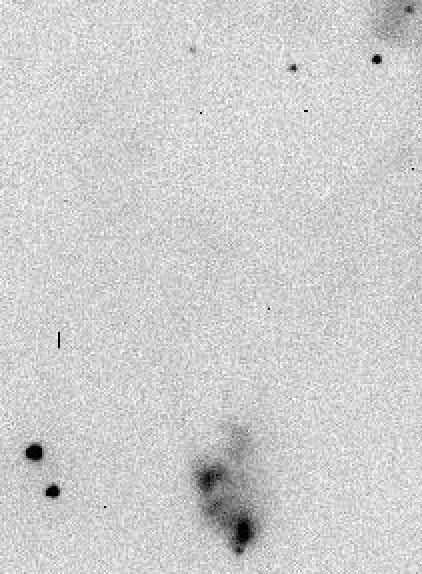
A deeper image from the paper shows the region around the new star more clearly; click on the image below for a larger version.
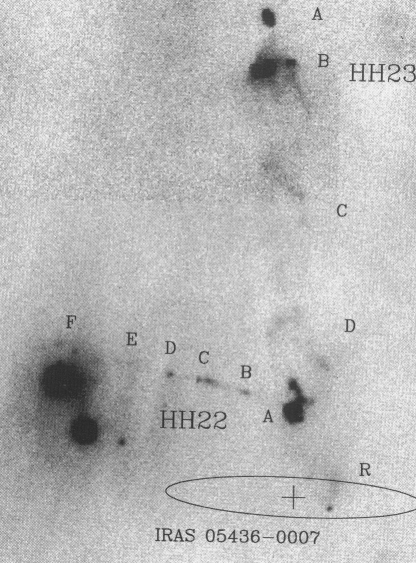
As Eisloffel and Mundt state, what we see to the right (west) of the double star is a combination of two different sources:
- the bright knot of nebulosity due west of the double stars, marked "A" in the chart above, lies at the end of a jet, marked by a series of condensations. This jet presumably originates in a star somewhere to the east (left) of the chain, but Eisloffel and Mundt couldn't find any source in the right place
- the nebulosity labelled "HH23", to the north of the double stars, appears to be the terminus of a jet coming from the south. It looks like the source might be near the cross, which marks the infrared source IRAS 05436-0007. That is also the location of the new star which has just recently become visible in the optical.
These images suggest (to me, at least) that the blob of nebulosity "A" just north of the new star may not be coupled to it directly; it may very well be in the foreground or background. However, on the other hand, when we go back to look at Kreimer's image back in 1966 (shown below at far right) we see that BOTH the southern core (corresponding to the IRAS source and newly visible star) AND the northern blob "A" both appear bright!
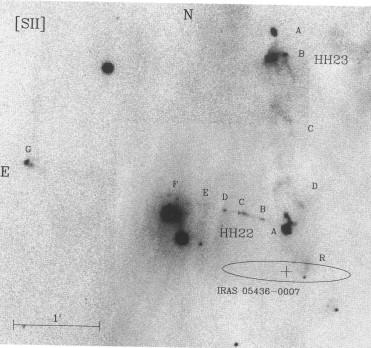
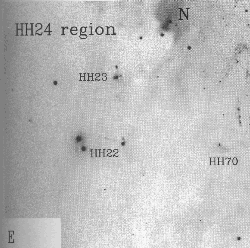
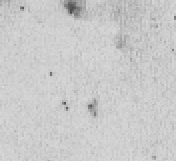
So this is a mystery: if the knot "A" belongs to the west-going jet from HH22, and the new star makes a north-going jet upwards towards HH23, why should both knot "A" and the new star appear brighter than usual at the same time back in 1966? Is it possible that the knot "A" is a product of both outflows, which happen to run into each other by some coincidence?
On to the paper on infrared imaging by Lis et al.. Their figure 5 shows the area around HH22, taken in January 1997:
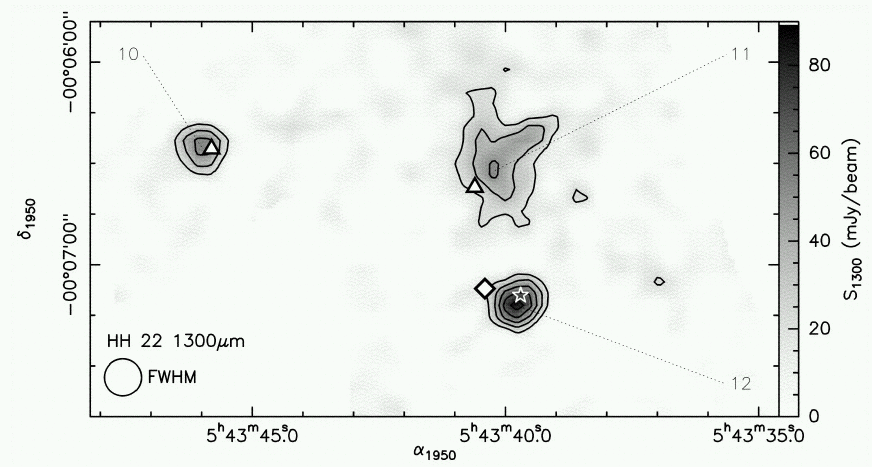
Let's compare it to the [SII] image of Eisloffel and Mundt:
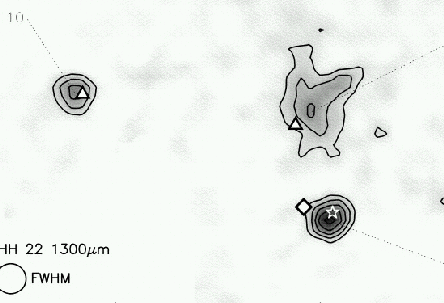
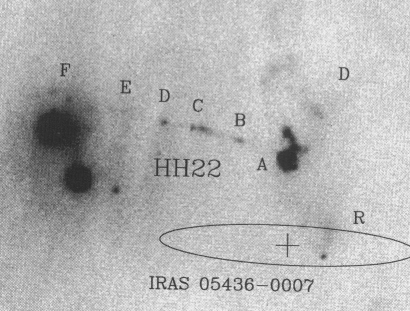
It seems that
- the new star, which Lis et al. called "LMZ 12", is a strong source of far-IR continuum radiation.
- the far-IR emission to its north may be due to the outflow from LMZ 12, or from HH22, or from both
Lis et al. provide measurements of LMZ 12 at several passbands in the far-IR in their Figure 6: the two longest, 350 and 1300 microns, they determined themselves in January, 1997; the four other data are taken from IRAS, which observed the area sometime in the early 1980s. Lis et al. describe how they were unsatisfied with the IRAS catalog entry at 60 microns and re-derived the flux at that wavelength. Given what we know now about the variability of the object, it's not clear that combining measurements taken 15 years apart is a good idea.
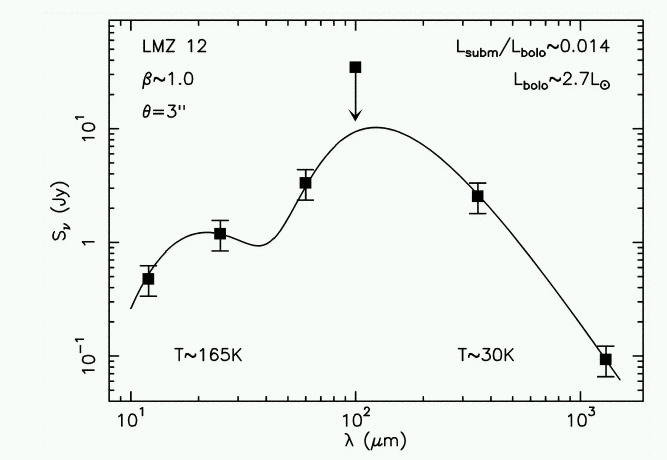
This color composite comes from the Sloan Digital Sky Survey: blue = the 'g' filter (centered on 4700 Angstroms), green = the 'r' filter (6200 Angstroms, includes H-alpha), red = the 'i' filter (7500 Angstroms). Thanks to David Schlegel and Jill Knapp for providing it! Click on the image for the full-size version.
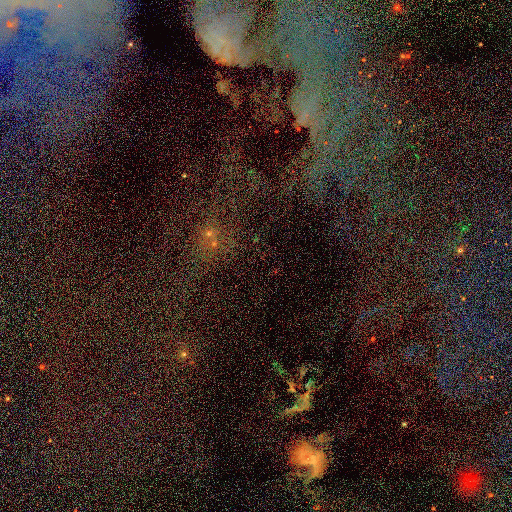
Added Feb 28, 2004
Thanks to Steve Kent and the Sloan Digital Sky Survey , here are two pictures of the field from a few years back: one from 1998 and another from 2002.
Taken in November, 1998:
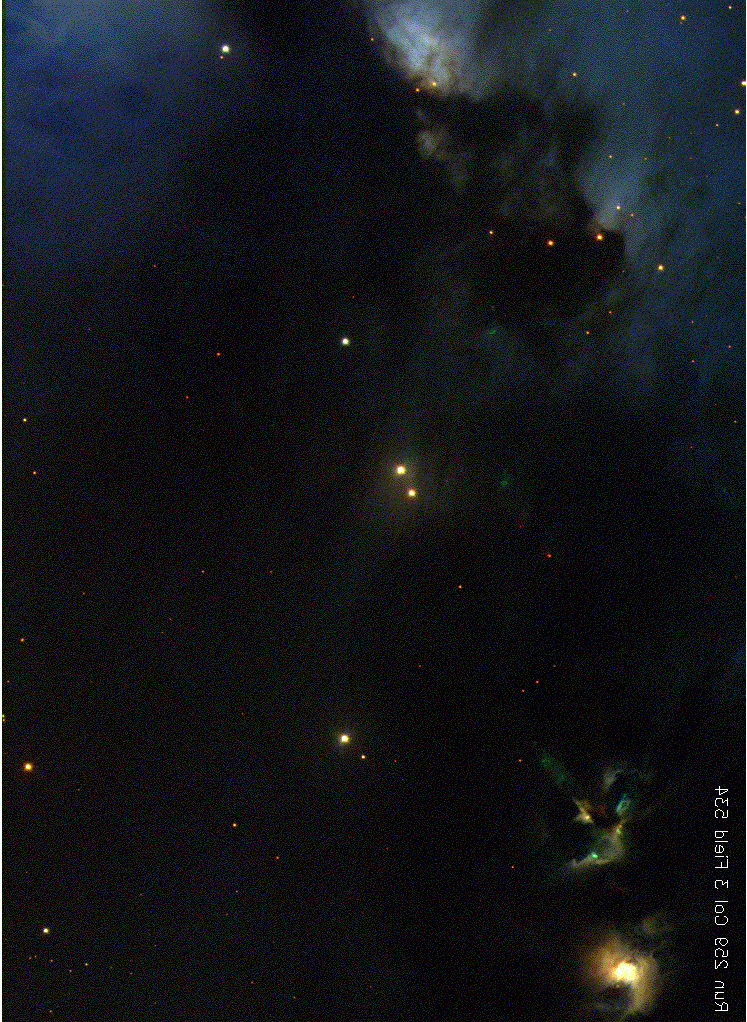
Taken in February, 2002:
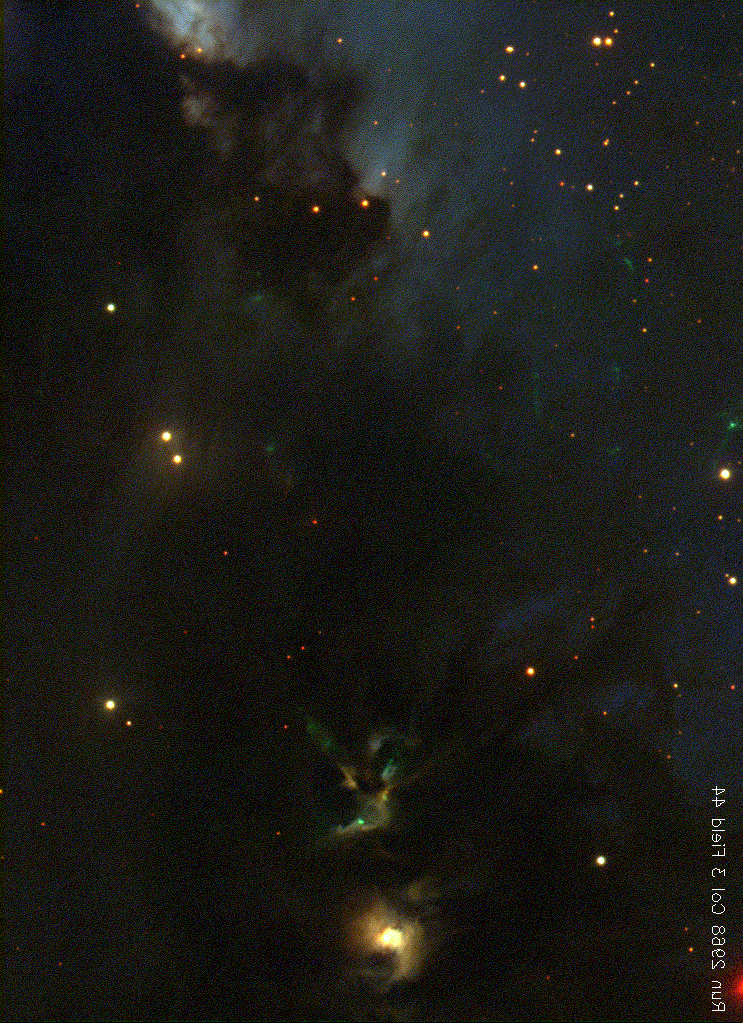
Added Mar 1, 2004
Arne Henden has made a nice color composite from images in B, V and I, taken with the USNO 1.55 m telescope on Feb 22, 2004. Click on the image below for a full-size version.
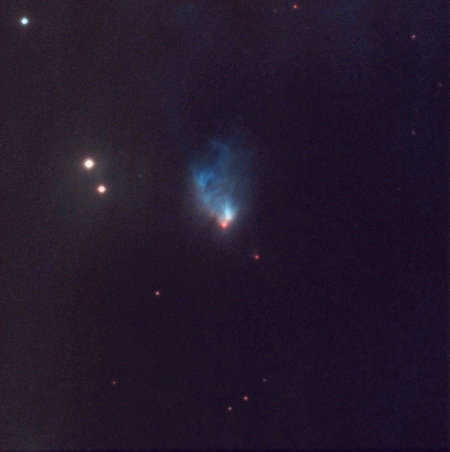
Added May 13, 2004
Doug Finkbeiner provides _big_ color mosaics from the Sloan Digital Sky Survey. Click on each thumbnail to download the full image. Beware -- they are around 8 MB each!
First, a composite of the g, r, i passbands:

Next, a composite of the r, i, z passbands (which go into the near-infrared):

For more information
- La nébuleuse nouvellement aperçue (le 01/23/2004), dans M78, la McNeil's Nebula provides information for Continental readers.
- Yasuo Sano's observations of the new star near M78
- Gianluca Masi's collection of information about the new star, and about the variability of one of its neighbors (a T Tauri star).
- The SEDS page on the new star , which is part of their excellent collection of information on the Messier Catalog.
- Bruce Gary's optical light curves of the new star.


